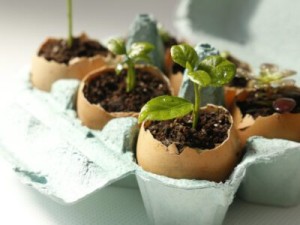 Not long ago the mailman dropped off the wonderful snowdrop catalog that my friend, Hitch Lyman, puts out every year. As you might expect, Hitch always waxes poetic, practical and whimsical about his line-up of unusual snowdrops, but he also has a long history of including inspiring quotes on the back cover. This year’s quote was lengthy and came from cookbook author/chef/historian Edna Lewis’s wonderful book, The Taste of Country Cooking. The last paragraph describes the way the author’s mother started bean seeds in eggshells every February. In less than one hundred words, Miss Lewis—courtesy of Mr. Lyman—rekindled my enthusiasm for starting seeds in this humble, old-fashioned way.
Not long ago the mailman dropped off the wonderful snowdrop catalog that my friend, Hitch Lyman, puts out every year. As you might expect, Hitch always waxes poetic, practical and whimsical about his line-up of unusual snowdrops, but he also has a long history of including inspiring quotes on the back cover. This year’s quote was lengthy and came from cookbook author/chef/historian Edna Lewis’s wonderful book, The Taste of Country Cooking. The last paragraph describes the way the author’s mother started bean seeds in eggshells every February. In less than one hundred words, Miss Lewis—courtesy of Mr. Lyman—rekindled my enthusiasm for starting seeds in this humble, old-fashioned way.
The quote also triggered a thought cascade that brought to mind Celia Thaxter’s An Island Garden, which described the late nineteenth century summer garden she kept on Appledore Island, off the New Hampshire coast. New Hampshire has a relatively short growing season, so annuals need a head start. Each year, in very late spring, Thaxter would board a boat and transport her infant garden of flowering annuals from the mainland to the island, the young seedlings traveling snug in their eggshell starter pots.
When you think about it, an eggshell is the perfect container in so many ways. Designed by Nature to cradle a young bird, it is simple, light, and ultimately, biodegradable. It holds just the right amount of soil for a seedling and is easy to water. You can fit your nascent nursery in an old egg box, which is also the perfect shape to rest on a windowsill. Once the soil warms, all you have to do is plant the eggshell in the appointed garden spot. No disturbance of the seedling is necessary. The bit of calcium in the shell breaks down and enriches the soil.
The eggshell method, similar to the paper cup method, is also perfect for young children and works especially well for plants with big seeds. Sunflowers come to mind, but sweet peas, nasturtiums and morning glories are also good choices. For vegetable gardeners, anything in the cucurbit family—pumpkins, squash or cucumbers—would also work well, not to mention peas or beans.
Smaller seeds are harder to see and handle, but work equally well in eggshells, Plant two or three seeds per shell and then snip off the weakest seedlings after all are fully emerged.
I made a quiche last night and broke the eggs carefully so I could save the shells. Washed and air-dried, they are now sitting in an egg box, awaiting the arrival of the annual seeds that I ordered the other day. By the time the seeds arrive, I will have filled the egg box and it will be time to sow seeds so that I will have seedlings ready when the warmer weather sets in.
I am going to start with sweet peas, plants that have been the object of my desire and the bane of my existence for much of my gardening life. To succeed in my climate, when even late spring is likely to turn hot and humid, sweet peas must be started and planted out early. The only way to accomplish this is to start them inside. In my latest triumph of hope over experience, I have ordered two packs of the most fragrant varieties, the old-fashioned Cupani type with their rich colors, and the equally nostalgic ‘Old Spice Mix’, which smells exactly as the name implies. The big pea-like seeds will go right into my eggshells and perhaps magic will happen. I have the perfect place for them in the garden, with their backs to the trellising that bounds my porch. My fingers are crossed and my shells are ready.
If you are of a mind to try the eggshell method, either for novelty value, because you have children or grandchildren, or for any other reason, start saving those shells now. When you are ready to plant, fill each one with two or more tablespoons of potting mix, plant and cover the seed according to packet directions, and give each eggshell about one tablespoon of water to get things started. Place the egg box on a sunny windowsill. Watch for emerging seedlings and water gently every day or so, being careful that the soil does not get too wet. When things warm up outside, generally when nighttime air temperatures are 50 degrees or above, take your egg boxes out and put them in a sheltered spot for a few days to accustom the young plants to the change in light and air temperature. After that, plant them out in beds or containers and watch them grow.
There are lots of seed starting methods and “systems” out there, some of them relatively costly. I advocate using anything that works for you, because the goal is to grow plants for your garden. Growing from seed allows you to experiment with all kinds of varieties that are not readily available as starter plants. Remember that if you are growing annuals, pick or deadhead regularly to keep the flowers coming throughout the season.
Using eggshells to start seeds makes me feel as if I am channeling gardeners long past. To match that historic method with heirloom varieties, try Select Seeds, 180 Stickney Hill Road, Union, CT 06076; www.selectseeds.com. Print catalog available.
